Top 10 recommendations
From findings & insights to action
Turning patterns into practical guidance
If you have explored the findings pages, you will have seen certain themes surface again and again, revealing the dynamics that shape how change unfolds across roles, regions and organization sizes. Some appear differently depending on context, yet the underlying patterns remain strikingly consistent.
The Top 10 Recommendations below bring these insights together. Each one is grounded in the data gathered through the State of Change Management in the Nonprofit Sector 2025 study and enriched by the practitioner perspectives of the Advisory Board, whose members contributed their field experience to interpreting what the numbers mean in practice. Together, these recommendations highlight where focused attention makes the biggest difference in whether change gains traction or loses momentum, even when time, money and energy are limited.
They are offered as starting points for reflection and action, guided by the same principle that underpins the entire study: that effective change in nonprofits should always be practical, pragmatic and proportional.
1. Make capacity checks routine
One of the clearest findings in the survey is that most nonprofits launch new projects without asking whether people actually have the bandwidth. Organizations that checked workload before starting were about 8 times more likely to keep up with change.
Capacity checks don’t need to be complex. A quick team discussion, a short pulse survey or simply asking “what would it take for this to work?” can make the invisible visible. The goal is not a quick yes or no, but an honest look at what people can realistically take on. Making it routine keeps ambitions realistic and prevents overload.
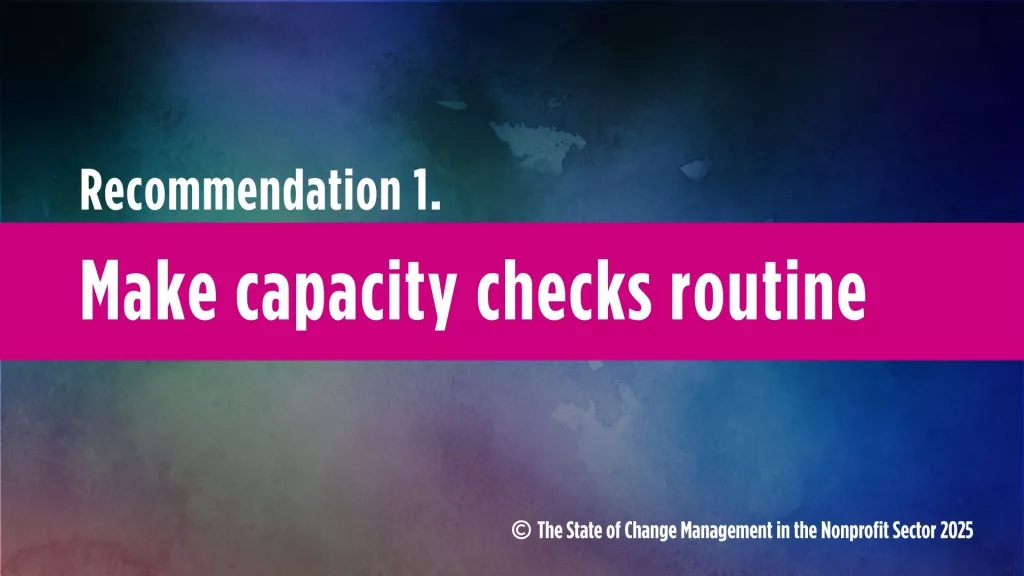
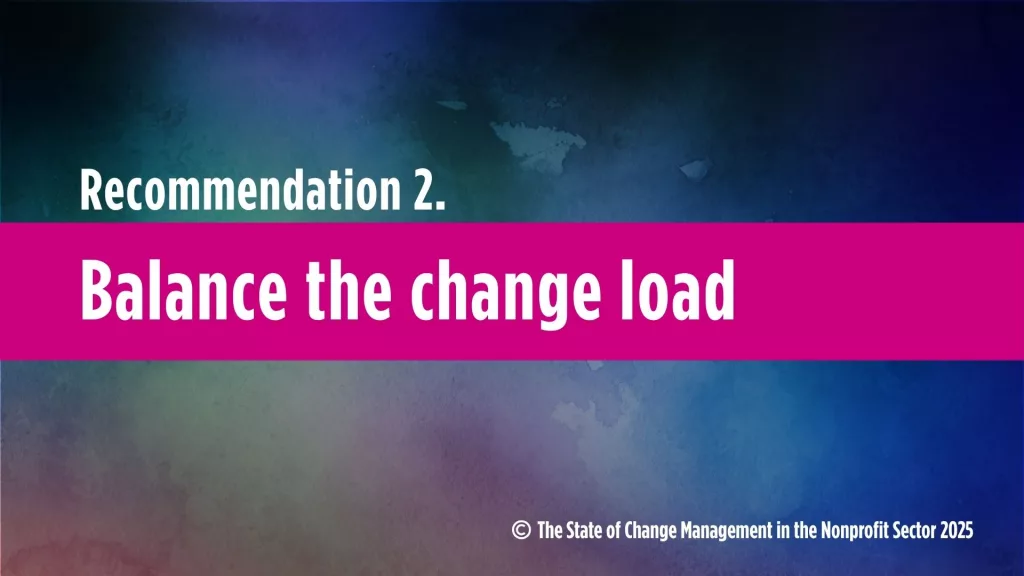
2. Balance the change load
Trying to do too much at once is one of the strongest risk signals in the dataset. Many nonprofits reported running multiple initiatives in parallel, with only a handful saying they could keep up well.
Balancing the load means limiting how many initiatives run at the same time. Quick workload checks before starting something new help decide what should be sequenced, scaled or done differently, while ensuring that major efforts stay aligned with the strategic plan and supported by the right structures and resources.
3. Use AI as a capacity boost, not a distraction
The survey shows most nonprofits are only at the starting line with AI and other emerging technologies. Few have a clear strategy, and many are only beginning to test possibilities.
The opportunity is to explore AI pragmatically, in small and mission-focused ways. Pilots and experiments aligned with the organization’s mission can unlock capacity without draining attention or chasing hype.
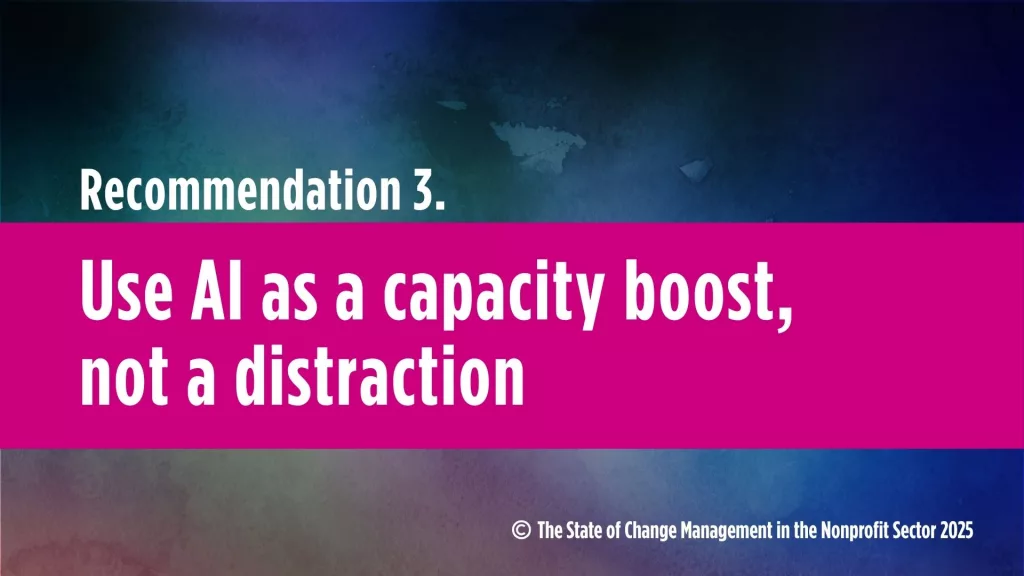
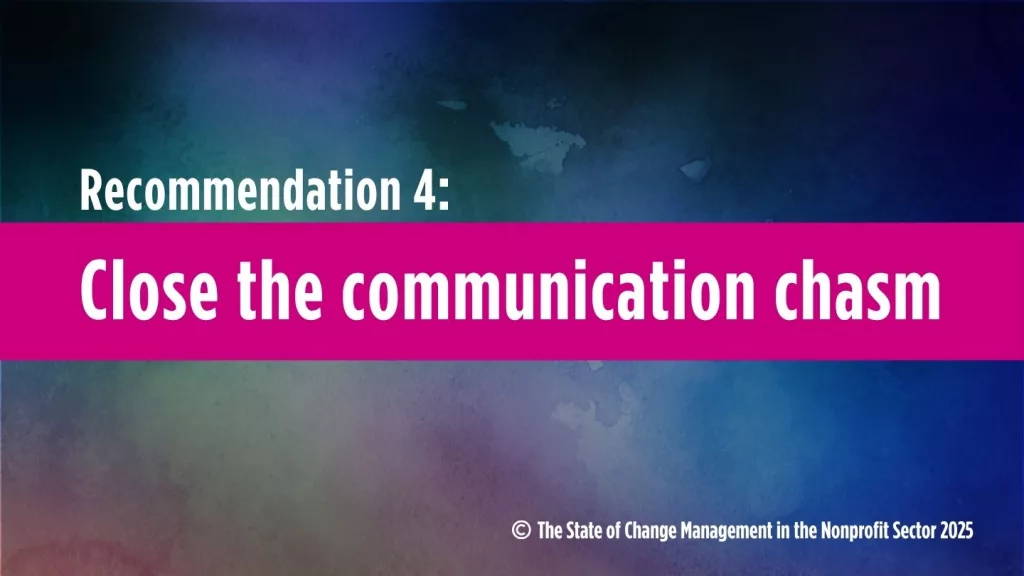
4. Close the communication chasm
In many nonprofits, leaders feel they are showing strong support, yet managers and specialists say the opposite. This disconnect slows down change and frustrates staff.
The answer is not more announcements but more dialogue. Leaders need to ask whether their messages are understood and create space for managers and others to voice or surface gaps or concerns. Dialogue works best when it’s steady and ongoing, not one-off, and when it connects clearly to the organization’s values and strategic direction. Managers play a critical role as ambassadors: They need context and information to help others see how change aligns with purpose. Only then does support become real across the organization.
5. Strengthen support for managers & teams
Survey responses show managers consistently report weaker support than executives do. Managers rated leadership support at about half the level reported by executives.
Support does not require new structures. Practical steps could include providing shared tools, giving managers access to peer exchanges, holding regular check-ins, actively listening and considering concerns and ensuring visible backing from senior leaders. Leaders also need to demonstrate that change aligns with the organization’s values and strategic direction and equip managers with the information and confidence to champion it effectively.
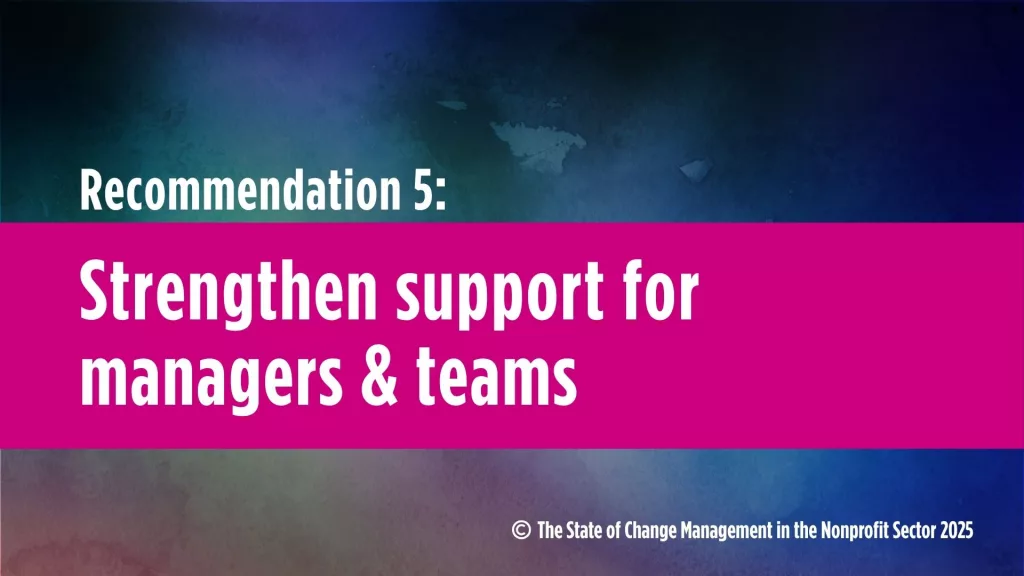
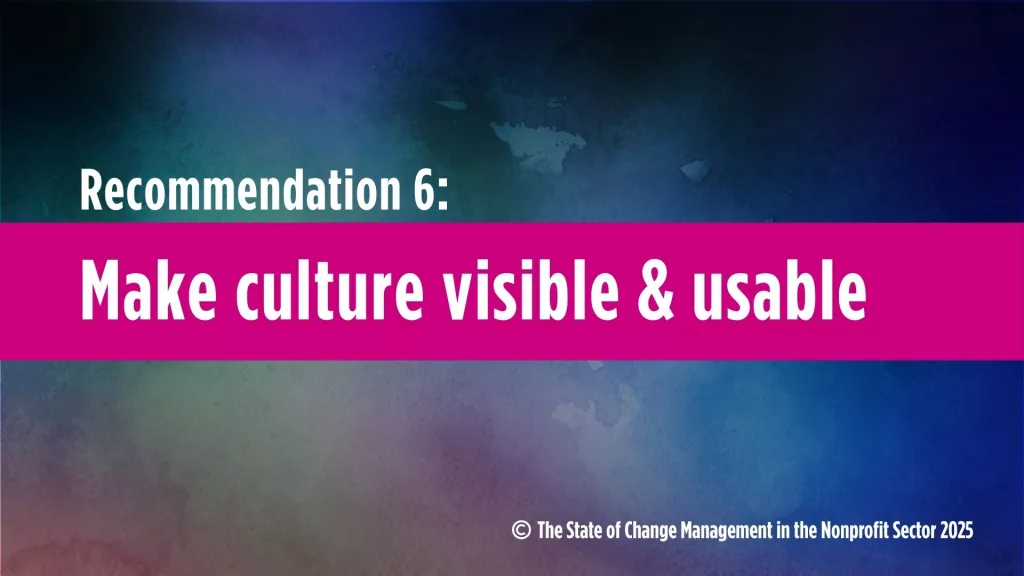
6. Make culture visible & usable
The survey shows that culture plays a double role in shaping how nonprofits handle change. On the enabling side, respondents pointed to mission-driven commitment, a collaborative and open environment, and a learning mindset that makes people adaptable. On the hindering side, they highlighted hierarchical decision-making, risk aversion and an overemphasis on consensus and participation that can slow progress.
Naming these dimensions makes culture usable. Strengthen and protect the enablers, while tackling the blockers directly. Leaders who recognize culture as both an asset and a barrier can turn it into a lever for change rather than leaving it in the background.
7. Build change into strategy & budgets
Many nonprofits treat the people side of change as an afterthought. Fewer than 1 in 4 nonprofits reported setting aside a budget for staff support during change.
Embedding change into strategy and budgets signals that it is part of the real work. Even a modest line for staff time, communication, training or coaching in every project plan makes adaptation visible and legitimate.
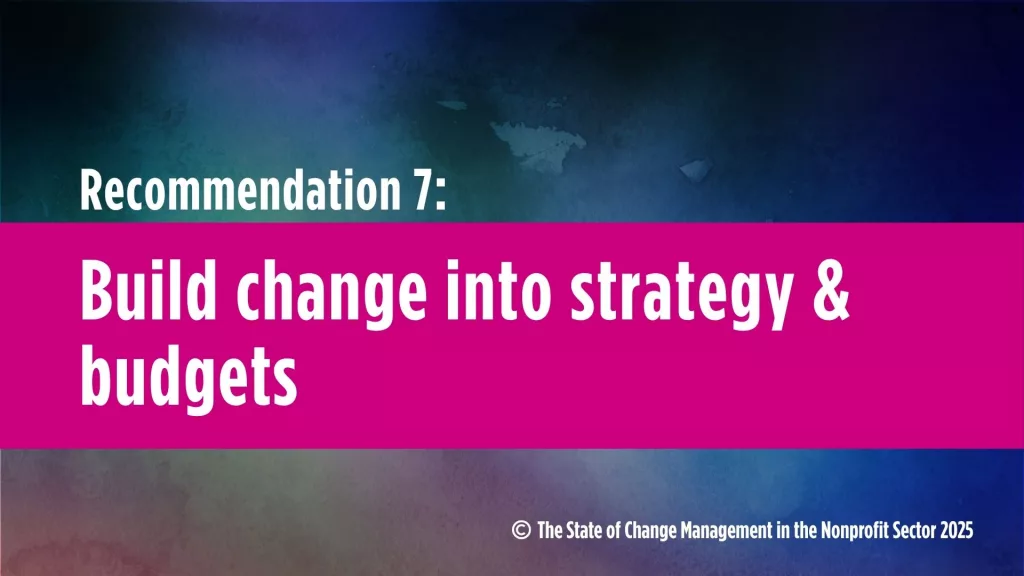

8. Turn frameworks into daily practice
Having a model or framework is not the same as using it. Over 40% of organizations said they had a framework, but only around 20% reported using it consistently.
To close the gap, keep things simple. Use a shared change log, short checklists or regular manager briefings that make the approach visible in daily work. A small set of routines applied consistently is more effective than elaborate plans that never get used.
9. Track outcomes, not just activity
Most nonprofits measure activity — how many people attended a training, how many meetings were held — but stop short of asking whether these changes made a difference. Without outcome data, it is hard to prove value or learn from experience.
Adding even one or two outcome indicators changes the picture. Checking whether a new process saves time, improves service quality or strengthens results connects effort to benefit and supports better decisions.
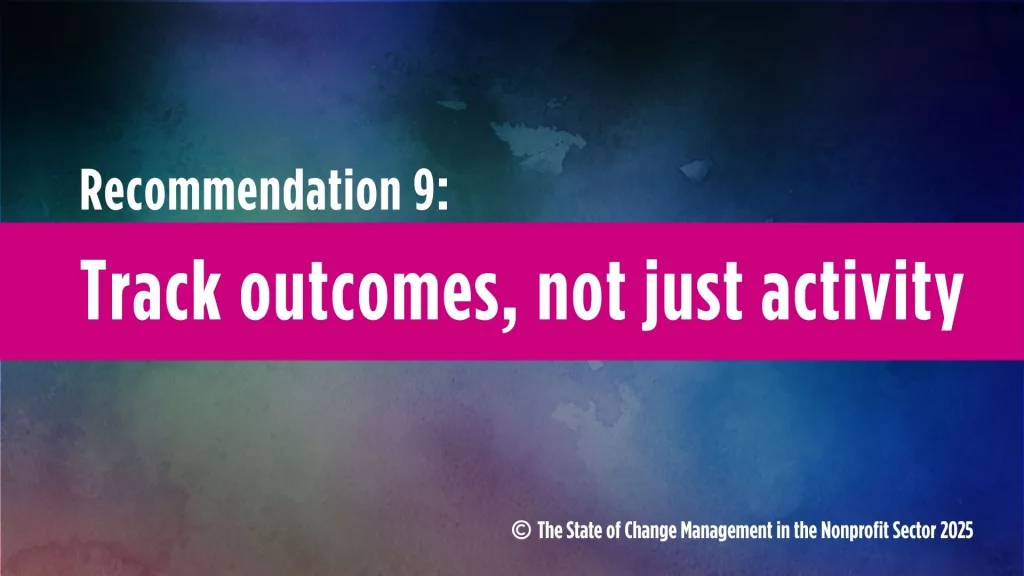

10. Mobilize overlooked resources
Volunteers, informal leaders and external partners are often left out of change efforts. Yet the survey shows they can provide critical energy and skills, especially when core staff are stretched thin.
Involving these groups early adds capacity without major cost. It also makes change more inclusive, ensuring people who care about the mission are part of shaping how it evolves.
Coming soon:
The Recommendations Playbook
The Playbook will build on these insights with practical guidance tailored by role and organization size. Subscribe below to receive early access once it’s released.
Audio summary of the recommendations
These audio summaries were generated automatically using Google NotebookLM. Each provides an AI-assisted overview of the Top 10 Recommendations document. While reviewed for basic accuracy, it may not fully reflect the nuance or phrasing of the original text.